MIMO技术的简介
- 格式:pdf
- 大小:1022.75 KB
- 文档页数:7

mimo 技术的三种模式介绍,mimo 技术作用,mimo 技
术种类
一、MIMO 定义
MIMO 即多入多出技术(MulTIple-Input MulTIple-Output)技术指在发射端和接收端分别使用多个发射天线和接收天线,使信号通过发射端与接收端的多个天线传送和接收,从而改善通信质量。
它能充分利用空间资源,通过多个天线实现多发多收,在不增加频谱资源和天线发射功率的情况下,可以成倍的提高系统信道容量,显示出明显的优势、被视为下一代移动通信的核心技术。
二、MIMO 技术分类
空分复用
(spaTIal mulTIplexing)工作在MIMO 天线配置下,能够在不增加带宽的条件下,相比SISO 系统成倍地提升信息传输速率,从而极大地提高了频谱利用率。
在发射端,高速率的数据流被分割为多个较低速率的子数据流,不同的子数据流在不同的发射天线上在相同频段上发射出去。
如果发射端与接收端的天线阵列之间构成的空域子信道足够不同,即能够在时域和频域之外额外提供空域的维度,使得在不同发射天线上传送的信号之间能够相互区别,因此接收机能够区分出这些并行的子数据流,而不需付出额外的频。
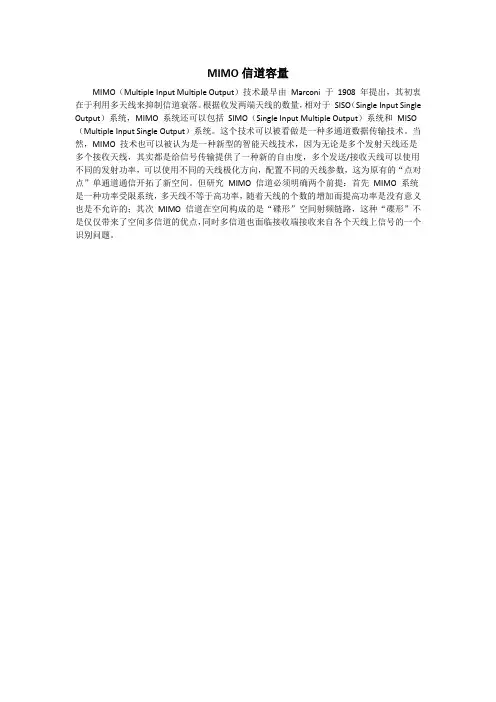
MIMO信道容量
MIMO(Multiple Input Multiple Output)技术最早由Marconi 于1908 年提出,其初衷在于利用多天线来抑制信道衰落。
根据收发两端天线的数量,相对于SISO(Single Input Single Output)系统,MIMO 系统还可以包括SIMO(Single Input Multiple Output)系统和MISO (Multiple Input Single Output)系统。
这个技术可以被看做是一种多通道数据传输技术。
当然,MIMO 技术也可以被认为是一种新型的智能天线技术,因为无论是多个发射天线还是多个接收天线,其实都是给信号传输提供了一种新的自由度,多个发送/接收天线可以使用不同的发射功率,可以使用不同的天线极化方向,配置不同的天线参数,这为原有的“点对点”单通道通信开拓了新空间。
但研究MIMO 信道必须明确两个前提:首先MIMO 系统是一种功率受限系统,多天线不等于高功率,随着天线的个数的增加而提高功率是没有意义也是不允许的;其次MIMO 信道在空间构成的是“碟形”空间射频链路,这种“碟形”不是仅仅带来了空间多信道的优点,同时多信道也面临接收端接收来自各个天线上信号的一个识别问题。
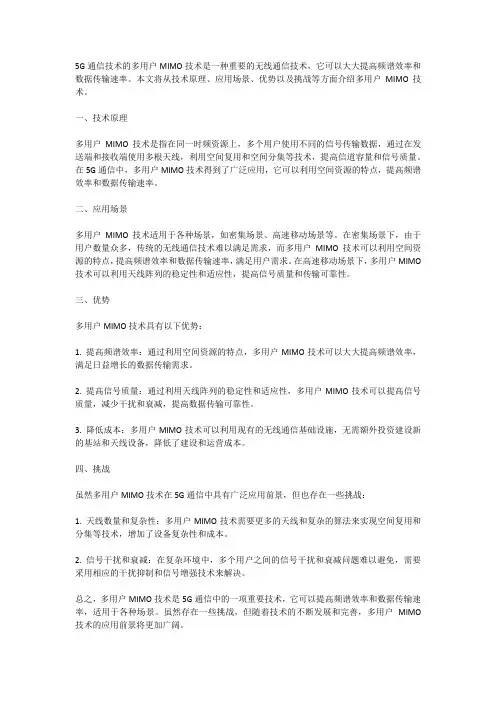
5G通信技术的多用户MIMO技术是一种重要的无线通信技术,它可以大大提高频谱效率和数据传输速率。
本文将从技术原理、应用场景、优势以及挑战等方面介绍多用户MIMO技术。
一、技术原理多用户MIMO技术是指在同一时频资源上,多个用户使用不同的信号传输数据,通过在发送端和接收端使用多根天线,利用空间复用和空间分集等技术,提高信道容量和信号质量。
在5G通信中,多用户MIMO技术得到了广泛应用,它可以利用空间资源的特点,提高频谱效率和数据传输速率。
二、应用场景多用户MIMO技术适用于各种场景,如密集场景、高速移动场景等。
在密集场景下,由于用户数量众多,传统的无线通信技术难以满足需求,而多用户MIMO技术可以利用空间资源的特点,提高频谱效率和数据传输速率,满足用户需求。
在高速移动场景下,多用户MIMO 技术可以利用天线阵列的稳定性和适应性,提高信号质量和传输可靠性。
三、优势多用户MIMO技术具有以下优势:1. 提高频谱效率:通过利用空间资源的特点,多用户MIMO技术可以大大提高频谱效率,满足日益增长的数据传输需求。
2. 提高信号质量:通过利用天线阵列的稳定性和适应性,多用户MIMO技术可以提高信号质量,减少干扰和衰减,提高数据传输可靠性。
3. 降低成本:多用户MIMO技术可以利用现有的无线通信基础设施,无需额外投资建设新的基站和天线设备,降低了建设和运营成本。
四、挑战虽然多用户MIMO技术在5G通信中具有广泛应用前景,但也存在一些挑战:1. 天线数量和复杂性:多用户MIMO技术需要更多的天线和复杂的算法来实现空间复用和分集等技术,增加了设备复杂性和成本。
2. 信号干扰和衰减:在复杂环境中,多个用户之间的信号干扰和衰减问题难以避免,需要采用相应的干扰抑制和信号增强技术来解决。
总之,多用户MIMO技术是5G通信中的一项重要技术,它可以提高频谱效率和数据传输速率,适用于各种场景。
虽然存在一些挑战,但随着技术的不断发展和完善,多用户MIMO 技术的应用前景将更加广阔。
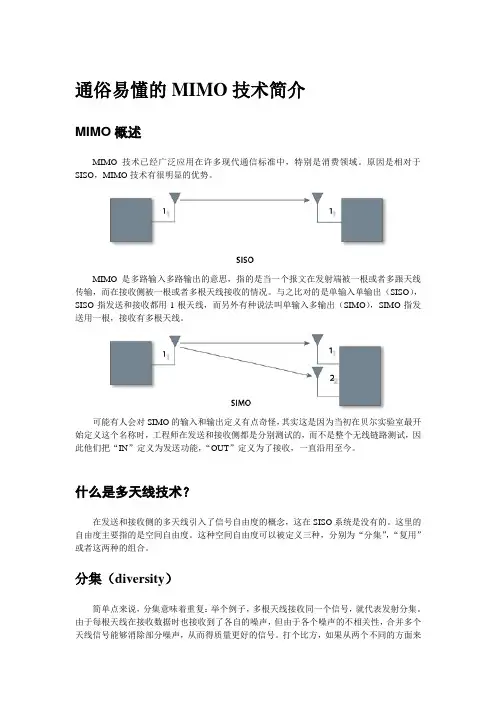
通俗易懂的MIMO技术简介MIMO概述MIMO技术已经广泛应用在许多现代通信标准中,特别是消费领域。
原因是相对于SISO,MIMO技术有很明显的优势。
MIMO是多路输入多路输出的意思,指的是当一个报文在发射端被一根或者多跟天线传输,而在接收侧被一根或者多根天线接收的情况。
与之比对的是单输入单输出(SISO),SISO指发送和接收都用1根天线,而另外有种说法叫单输入多输出(SIMO),SIMO指发送用一根,接收有多根天线。
可能有人会对SIMO的输入和输出定义有点奇怪,其实这是因为当初在贝尔实验室最开始定义这个名称时,工程师在发送和接收侧都是分别测试的,而不是整个无线链路测试,因此他们把“IN”定义为发送功能,“OUT”定义为了接收,一直沿用至今。
什么是多天线技术?在发送和接收侧的多天线引入了信号自由度的概念,这在SISO系统是没有的。
这里的自由度主要指的是空间自由度。
这种空间自由度可以被定义三种,分别为“分集”,“复用”或者这两种的组合。
分集(diversity)简单点来说,分集意味着重复:举个例子,多根天线接收同一个信号,就代表发射分集。
由于每根天线在接收数据时也接收到了各自的噪声,但由于各个噪声的不相关性,合并多个天线信号能够消除部分噪声,从而得质量更好的信号。
打个比方,如果从两个不同的方面来看同一个物件,那么得到的评价也会更可靠。
需要说明的是,分集并不一定要多个接收天线才能实现,后面就会讲到,分集也可以使用多个发送天线通过空时编码(STC )技术来实现。
空间复用(Spatial Multiplexing )第二个主要的MIMO 技术为空间复用,空间复用可以在不增加带宽和发送功率的情况下通过成对的MIMO 发送、接收来增加系统吞吐量。
空间复用增加的吞吐量与发送或接收天线数目(较少的那个)成线性关系。
空间复用中,每个传输天线发送不同的bit 流信息,每个接收天线收到来自所有传输天线的线性综合信息。
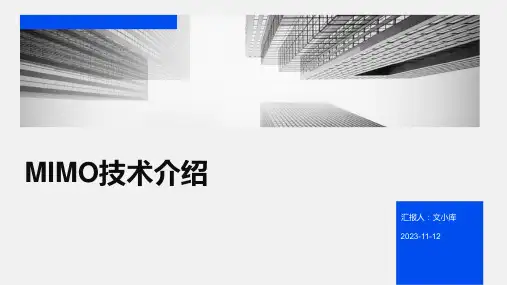

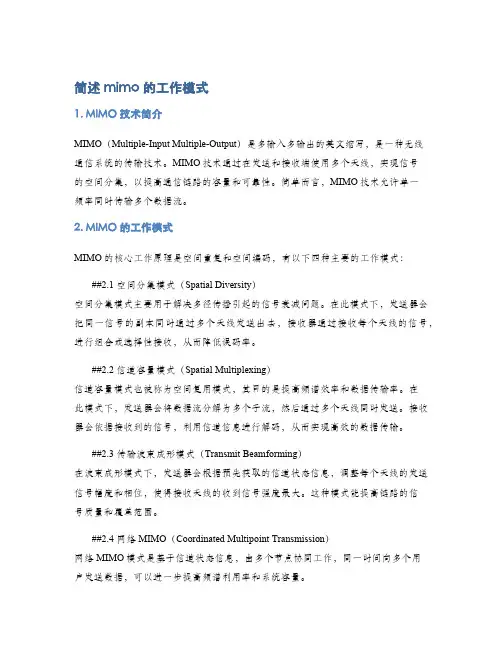
简述mimo的工作模式1. MIMO技术简介MIMO(Multiple-Input Multiple-Output)是多输入多输出的英文缩写,是一种无线通信系统的传输技术。
MIMO技术通过在发送和接收端使用多个天线,实现信号的空间分集,以提高通信链路的容量和可靠性。
简单而言,MIMO技术允许单一频率同时传输多个数据流。
2. MIMO的工作模式MIMO的核心工作原理是空间重复和空间编码,有以下四种主要的工作模式:##2.1 空间分集模式(Spatial Diversity)空间分集模式主要用于解决多径传播引起的信号衰减问题。
在此模式下,发送器会把同一信号的副本同时通过多个天线发送出去,接收器通过接收每个天线的信号,进行组合或选择性接收,从而降低误码率。
##2.2 信道容量模式(Spatial Multiplexing)信道容量模式也被称为空间复用模式,其目的是提高频谱效率和数据传输率。
在此模式下,发送器会将数据流分解为多个子流,然后通过多个天线同时发送。
接收器会依据接收到的信号,利用信道信息进行解码,从而实现高效的数据传输。
##2.3 传输波束成形模式(Transmit Beamforming)在波束成形模式下,发送器会根据预先获取的信道状态信息,调整每个天线的发送信号幅度和相位,使得接收天线的收到信号强度最大。
这种模式能提高链路的信号质量和覆盖范围。
##2.4 网络 MIMO(Coordinated Multipoint Transmission)网络MIMO模式是基于信道状态信息,由多个节点协同工作,同一时间向多个用户发送数据,可以进一步提高频谱利用率和系统容量。
3. MIMO的发展和应用MIMO技术作为现代无线通信系统的重要技术之一,已广泛应用于无线局域网、蜂窝移动通信、无线传感网络等领域。
随着科技的不断进步,MIMO技术还有望在未来的5G甚至6G通信系统中发挥重要作用。
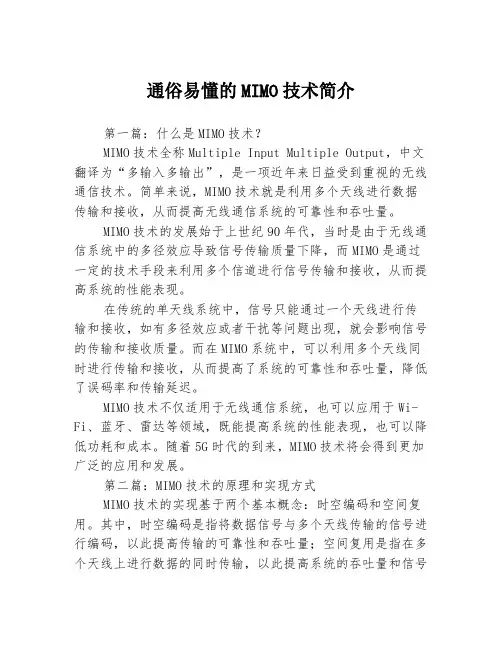
通俗易懂的MIMO技术简介第一篇:什么是MIMO技术?MIMO技术全称Multiple Input Multiple Output,中文翻译为“多输入多输出”,是一项近年来日益受到重视的无线通信技术。
简单来说,MIMO技术就是利用多个天线进行数据传输和接收,从而提高无线通信系统的可靠性和吞吐量。
MIMO技术的发展始于上世纪90年代,当时是由于无线通信系统中的多径效应导致信号传输质量下降,而MIMO是通过一定的技术手段来利用多个信道进行信号传输和接收,从而提高系统的性能表现。
在传统的单天线系统中,信号只能通过一个天线进行传输和接收,如有多径效应或者干扰等问题出现,就会影响信号的传输和接收质量。
而在MIMO系统中,可以利用多个天线同时进行传输和接收,从而提高了系统的可靠性和吞吐量,降低了误码率和传输延迟。
MIMO技术不仅适用于无线通信系统,也可以应用于Wi-Fi、蓝牙、雷达等领域,既能提高系统的性能表现,也可以降低功耗和成本。
随着5G时代的到来,MIMO技术将会得到更加广泛的应用和发展。
第二篇:MIMO技术的原理和实现方式MIMO技术的实现基于两个基本概念:时空编码和空间复用。
其中,时空编码是指将数据信号与多个天线传输的信号进行编码,以此提高传输的可靠性和吞吐量;空间复用是指在多个天线上进行数据的同时传输,以此提高系统的吞吐量和信号质量。
时空编码主要有两种方式:空时块码(STBC)和空时分组码(STGC)。
其中,STBC是在时间和空间两个方向进行数据编码,以此提高传输可靠性,适用于多径效应较强的无线环境;STGC则是在时间和频域两个方向进行数据编码,以此提高传输速率,适用于高速无线通信环境。
空间复用技术则主要有两种方式:空分多路复用(SDM)和空时多路复用(STDM)。
其中,SDM是通过将数据进行分割,然后分别发送到多个天线上,以此提高系统的吞吐量;STDM则是通过将不同的数据序列分成多个时间片段,在不同天线上传输,以此降低多径效应和干扰对系统的影响。

mimo的原理及应用1. MIMO的简介多输入多输出(Multiple-Input Multiple-Output,MIMO)是一种无线通信技术,通过在多个天线之间传输和接收数据,提高无线信号的传输效率和可靠性。
MIMO技术在现代无线通信系统中得到了广泛应用,包括LTE、Wi-Fi和5G等。
2. MIMO的原理MIMO技术基于空间分集原理,利用多个天线同时发送和接收独立的数据流,通过多径传播的特性,将数据流在空间中分离出来,从而提高信号的传输速率和抗干扰能力。
MIMO系统的原理可以简单描述为以下几个步骤:1.信号发射端:将要发送的数据流分为多个独立的子流,并通过不同的天线同时发送。
2.多径传播:由于无线信号在传播过程中会经历多条路径,每条路径上的传播特性不同,因此到达接收端的信号会被分为多个不同的子信号。
3.空间分离:接收端的天线接收到的信号会受到多径效应的影响,通过对接收信号进行处理,可以将各个子信号分离出来。
4.信号处理:接收端对接收到的子信号进行处理和解调,恢复原始数据。
3. MIMO的优势和应用MIMO技术具有以下几个优势,使其在无线通信系统中得到广泛应用:3.1 增强信号传输速率通过多个天线同时发送和接收多个子信号,MIMO技术可以大大增加信号的传输速率。
每个天线都可以发送不同的数据流,从而增加了系统的总传输能力。
3.2 提高系统容量和覆盖范围MIMO技术通过空间分集原理,可以在有限的频谱资源下提高系统的容量。
通过合理设计和布置天线,可以达到更好的信号覆盖范围,提供更稳定和高质量的无线通信服务。
3.3 抗干扰和抑制多径衰落由于MIMO系统利用了多个天线和多径传播的特性,可以利用接收信号的空间分离性质抑制干扰信号和多路径信号的衰落。
这使得MIMO系统在复杂的无线信道中具有较好的抗干扰能力和稳定性。
3.4 支持多用户和多任务传输MIMO技术可以同时为多个用户提供高速和可靠的无线通信服务,支持多用户之间的同时传输。
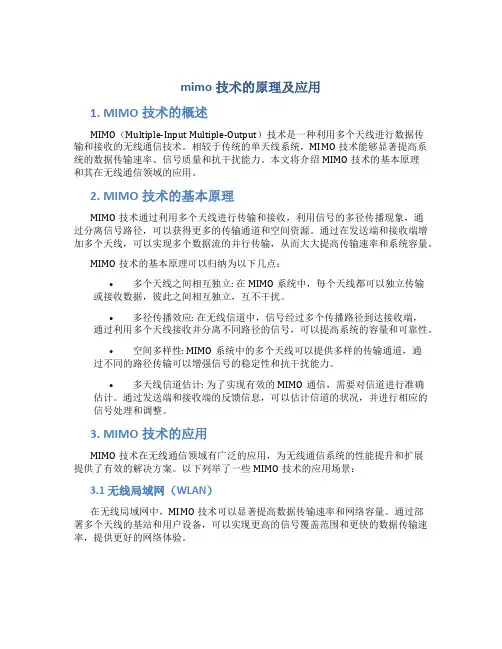
mimo技术的原理及应用1. MIMO技术的概述MIMO(Multiple-Input Multiple-Output)技术是一种利用多个天线进行数据传输和接收的无线通信技术。
相较于传统的单天线系统,MIMO技术能够显著提高系统的数据传输速率、信号质量和抗干扰能力。
本文将介绍MIMO技术的基本原理和其在无线通信领域的应用。
2. MIMO技术的基本原理MIMO技术通过利用多个天线进行传输和接收,利用信号的多径传播现象,通过分离信号路径,可以获得更多的传输通道和空间资源。
通过在发送端和接收端增加多个天线,可以实现多个数据流的并行传输,从而大大提高传输速率和系统容量。
MIMO技术的基本原理可以归纳为以下几点:•多个天线之间相互独立: 在MIMO系统中,每个天线都可以独立传输或接收数据,彼此之间相互独立,互不干扰。
•多径传播效应: 在无线信道中,信号经过多个传播路径到达接收端,通过利用多个天线接收并分离不同路径的信号,可以提高系统的容量和可靠性。
•空间多样性: MIMO系统中的多个天线可以提供多样的传输通道,通过不同的路径传输可以增强信号的稳定性和抗干扰能力。
•多天线信道估计: 为了实现有效的MIMO通信,需要对信道进行准确估计。
通过发送端和接收端的反馈信息,可以估计信道的状况,并进行相应的信号处理和调整。
3. MIMO技术的应用MIMO技术在无线通信领域有广泛的应用,为无线通信系统的性能提升和扩展提供了有效的解决方案。
以下列举了一些MIMO技术的应用场景:3.1 无线局域网(WLAN)在无线局域网中,MIMO技术可以显著提高数据传输速率和网络容量。
通过部署多个天线的基站和用户设备,可以实现更高的信号覆盖范围和更快的数据传输速率,提供更好的网络体验。
3.2 移动通信系统MIMO技术在移动通信系统中的应用非常广泛,特别是在4G和5G系统中。
通过利用多个天线进行多流束传输和接收,可以提高系统的容量和覆盖范围,提供更稳定和高速的移动通信服务。
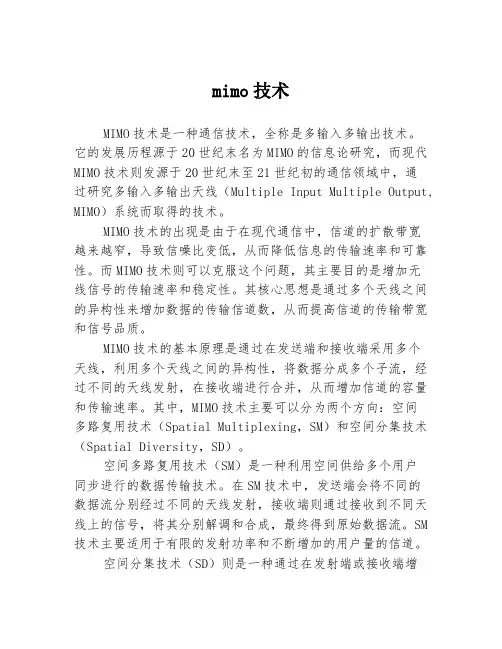
mimo技术MIMO技术是一种通信技术,全称是多输入多输出技术。
它的发展历程源于20世纪末名为MIMO的信息论研究,而现代MIMO技术则发源于20世纪末至21世纪初的通信领域中,通过研究多输入多输出天线(Multiple Input Multiple Output, MIMO)系统而取得的技术。
MIMO技术的出现是由于在现代通信中,信道的扩散带宽越来越窄,导致信噪比变低,从而降低信息的传输速率和可靠性。
而MIMO技术则可以克服这个问题,其主要目的是增加无线信号的传输速率和稳定性。
其核心思想是通过多个天线之间的异构性来增加数据的传输信道数,从而提高信道的传输带宽和信号品质。
MIMO技术的基本原理是通过在发送端和接收端采用多个天线,利用多个天线之间的异构性,将数据分成多个子流,经过不同的天线发射,在接收端进行合并,从而增加信道的容量和传输速率。
其中,MIMO技术主要可以分为两个方向:空间多路复用技术(Spatial Multiplexing,SM)和空间分集技术(Spatial Diversity,SD)。
空间多路复用技术(SM)是一种利用空间供给多个用户同步进行的数据传输技术。
在SM技术中,发送端会将不同的数据流分别经过不同的天线发射,接收端则通过接收到不同天线上的信号,将其分别解调和合成,最终得到原始数据流。
SM 技术主要适用于有限的发射功率和不断增加的用户量的信道。
空间分集技术(SD)则是一种通过在发射端或接收端增加多个天线的技术,通过差异化的传输,让接收端可以同时接收多个信号,从而降低噪声干扰和提高信号质量。
SD技术可以分为多种形式,包括时空分集、时度分集等技术,主要适用于复杂的移动环境以及需要高速可靠数据传输的场景。
MIMO技术的应用有很广泛。
在无线通信领域中,MIMO技术已被广泛应用于Wi-Fi、蓝牙、LTE、5G等技术的研究和应用中。
同时,在雷达探测、无线电广播、智能交通系统等领域中,MIMO技术也得到了广泛应用。
浅谈MIMO技术一、MIMO简介MIMO(Multiple—Input Multiple—Output)即是多输入多输出技术,是指在发射端和接收端分别使用多个发射天线和接收天线,信号通过发射端和接收端的多个天线传送和接收,从而改善每个用户的服务质量(误比特率或数据速率)。
MIMO系统根据收发两端天线数量,相对于普通的SISO(Single—Input Single-Output)系统,MIMO还可以包括MISO(Multiple-Input Single-Output)系统和SIMO(Single-Input Multiple-Output)系统.MISO系统SIMO系统1.MIMO的发展历史实际上多进多出(MIMO)技术由来已久,早在1908年马可尼就提出用它来抗衰落.在70年代有人提出将多入多出技术用于通信系统,但是对无线移动通信系统多入多出技术产生巨大推动的奠基工作则是由AT&TBell实验室学者完成的。
1995年Teladar给出了在衰落情况下的MIMO容量;1996年Foshinia给出了一种多入多出处理算法—-对角—贝尔实验室分层空时(D-BLAST)算法;1998年Tarokh等讨论了用于多入多出的空时码;1998年Wolniansky等人采用垂直-贝尔实验室分层空时(V—BLAST)算法建立了一个MIMO实验系统,在室内试验中达到了20bit/s/Hz以上的频谱利用率,这一频谱利用率在普通系统中极难实现。
这些工作受到各国学者的极大注意,并使得多入多出的研究工作得到了迅速发展。
至2010年年底,IEEE数据库收录该领域的研究论文已达上万篇,从MIMO无线通信技术的理论研究到实验验证,再到商用化的各个方面。
目前,国际上很多科研院校与商业机构都争相对MIMO通信技术进行深入研究。
2.MIMO 技术特点随着无线通信技术的快速发展,频谱资源的严重不足已经日益成为遏制无线通信事业的瓶颈。
MIMOMIMO属于空间分集简介MIMO(Multiple-Input Multiple-Out-put)系统是一项运用于802.11n的核心技术。
802.11n是IEEE继802.11b\a\g后全新的无线局域网技术,速度可达600Mbps。
同时,专有MIMO技术可改进已有802.11a/b/g网络的性能。
该技术最早是由Marconi于1908年提出的,它利用多天线来抑制信道衰落。
根据收发两端天线数量,相对于普通的SISO(Single-Input Single-Output)系统,MIMO还可以包括SIMO(Single-Input Multi-ple-Output)系统和MISO(Multiple-Input Single-Output)系统。
概述MIMO 表示多输入多输出。
读/maimo/或/mimo/,通常美国人读前者,英国人读后者,国际上研究这一领域的专家较多的都读/maimo/。
在第四代移动通信技术标准中被广泛采用,例如IEEE 802.16e (Wimax),长期演进(LTE)。
在新一代无线局域网(WLAN)标准中,通常用于 IEEE 802.11n,但也可以用于其他 802.11 技术。
MIMO 有时被称作空间分集,因为它使用多空间通道传送和接收数据。
只有站点(移动设备)或接入点(AP)支持 MIMO 时才能部署 MIMO。
优点MIMO 技术的应用,使空间成为一种可以用于提高性能的资源,并能够增加无线系统的覆盖范围。
无线电发送的信号被反射时,会产生多份信号。
每份信号都是一个空间流。
使用单输入单输出(SISO)的系统一次只能发送或接收一个空间流。
MIMO 允许多个天线同时发送和接收多个空间流,并能够区分发往或来自不同空间方位的信号。
多天线系统的应用,使得多达 min(Nt,Nr)的并行数据流可以同时传送。
同时,在发送端或接收端采用多天线,可以显著克服信道的衰落,降低误码率。
一般的,分集增益可以高达Nt*Nr。
MIMO(Multiple-Input Multiple-Output,多输入多输出)技术是指在发送端和接收端分别使用多个发送天线和接收天线,从而可以在发送端和接收端通过多个天线发送和接收信号,从而改善通信质量。
它可以充分利用空间资源,通过多根天线实现多次发射和多次接收,并且可以在不增加频谱资源和天线发射功率的情况下,倍增系统信道容量,具有明显的优势,被视为下一代移动通信的核心技术通讯。
MIMO(Multiple-Input Multiple-Output,多输入多输出)技术是指在发送端和接收端分别使用多个发送天线和接收天线,从而可以在发送端和接收端通过多个天线发送和接收信号,从而改善通信质量。
它可以充分利用空间资源,通过多根天线实现多次发射和多次接收,并且可以在不增加频谱资源和天线发射功率的情况下,倍增系统信道容量,具有明显的优势,被视为下一代移动通信的核心技术。
通讯。
当无线电发送的信号被反射时,将产生多个信号。
每个信号都是一个空间流。
使用单输入单输出(SISO)的系统一次只能发送或接收一个空间流。
MIMO允许多个天线同时发送和接收多个空间流,并且可以区分发送到不同空间方向或来自不同空间方向的信号。
随着MIMO技术的应用,空间可以用作资源来提高性能并增加无线系统的覆盖范围。
提高渠道容量,从MIMO接入点到MIMO客户端,可以同时发送和接收多个空间流,并且信道容量可以随着天线数量的增加而线性增加。
因此,可以将MIMO信道用于以指数方式增加无线信道容量,并且可以在不增加带宽和天线发射功率的情况下以指数方式增加频谱利用率。
提高渠道可靠性,使用MIMO信道提供的空间复用增益和空间分集增益,可以使用多个天线来抑制信道衰落。
随着多天线系统的应用,并行数据流可以同时传输,可以大大克服信道衰落,降低误码率。
MIMO技术介绍MIMO(Multiple-Input Multiple-Output)是一种无线通信技术,它通过在发送端和接收端使用多个天线来实现更高的频谱效率、更好的信号质量和更远的传输距离。
MIMO技术是由无线电通信中的多径效应所驱动的,这意味着信号从发送端到接收端会经历多个传播路径,并且会受到多种干扰的影响。
MIMO技术通过在发送端和接收端增加天线数量来增强信号的传输质量和信道容量。
MIMO技术可以追溯到20世纪60年代,在那个时候,人们开始研究多天线系统。
然而,由于当时计算能力的限制,直到近20年后才开始真正广泛应用。
现代MIMO技术发展起来主要依赖于两个重要的理论突破:空间复用理论和空间多样性理论。
空间复用理论是MIMO技术的基础,也是MIMO技术实现高频谱效率的关键。
通过在发送端和接收端使用多个天线,MIMO技术可以在同一频率上同时传输多个数据流。
在传统的无线通信系统中,每个频率只能传输一个数据流,而MIMO技术可以将多个数据流通过不同的路径并行地传输,从而提高频谱利用率和传输速率。
空间多样性理论是MIMO技术中的另一个重要概念。
它利用了多天线系统中多个信号间的独立性,以及每个接收天线对信号的不同接收质量。
通过在多个天线之间传输同样的数据,接收端可以通过综合不同路径上的信号来提高信号质量和抵抗干扰。
通过利用多个输入和输出,MIMO技术可以显著改善信号的可靠性和可达性。
MIMO技术的好处不仅仅体现在提高频谱效率上。
通过在发送端和接收端使用多个天线,MIMO技术可以提高信号的鲁棒性和抗干扰能力。
在无线通信中,信号往往会受到多径衰落、多径干扰以及其他用户的干扰。
MIMO技术可以通过综合多个信号来抵消这些干扰,从而提高信号质量和系统性能。
此外,MIMO技术还可以提供更好的覆盖范围和更远的传输距离,从而实现更可靠的无线通信。
实际应用中,MIMO技术已经广泛应用于4G和5G无线通信系统中。
在4G系统中,MIMO技术已经成为提高系统性能的关键技术之一、通过在发送端和接收端使用多个天线,4G系统可以显著提高频谱效率和传输速率,实现高速数据传输和多用户接入。
什么是MIMO技术?那么究竟什么是MIMO技术呢?通俗的说就是为了提升无线信号的传输质量,而利用多个天线将无线信号进行同步收发的无线技术。
MIMO(Multi-input Multi-output,多输入多输出)技术在维基百科中定义是一种用来描述多天线无线通信系统的抽象数学模型,能利用发射端的多个天线各自独立发送信号,同时在接收端用多个天线接收并恢复原信息。
MIMO多进多出无线技术在现在主流的802.11n无线产品中,MIMO架构是标志性的无线技术之一。
在无线通信领域中,MIMO技术中的智能天线技术是具有相当重要意义的,该技术能在不增加带宽的情况下成倍地提高通信系统的吞吐量、传送距离和频谱利用率。
应该说,一个无线通信系统只要其发射端和接收端同时都采用了多个天线(或者天线阵列),就构成了一个无线MIMO系统。
MIMO技术采用空间复用技术对无线信号进行处理后,数据通过多重切割之后转换成多个平行的数据子流,数据子流经过多副天线同步传输,在空中产生独立的并行信道传送这些信号流;为了避免被切割的信号不一致,在接收端也采用多个天线同时接收,根据时间差的因素将分开的各信号重新组合,还原出原本的数据。
使用MIMO技术的好处是,可以通过增大天线的数量来传输信息子流,将多个数据子流同时发送到信道上,各发射信号占用同一频带,从而在不增加频带宽度的情况下增加频谱利用率。
经测试,采用MIMO技术的无线局域网频谱利用率可达到20-40bps/Hz,非常适合在室内环境下的无线网络系统中应用。
综上所述,使用MIMO技术后,可以令无线信号的传输距离、天线的接受范围进一步扩大,信号抗干扰性更强,无线传输更为精准快速。
而前面针对提升手机在LTE或WiFi环境下的通讯品质,而推出的新式MIMO架构天线方案,无疑为用户带来了更流畅、快速的无线应用体验。
WiFi天线分集和MIMO的区别比较文/张利兵802.11a/b/g设备经常会见到配备有多个天线,这种天线形式就是天线分集(Antenna Diversity),而802.11n设备的MIMO系统也是多个天线,两种技术之间有何区别呢?1. 天线分集系统天线分集系统中,实际上只有一个收发器,而多个天线都连接着这个收发装置。
TELE 9754 Coding and InformationTheoryResearch Workshop ReportAbstract—Mobile wireless communication has become one of the most important aspects of our daily life. The continuously increasing usage has imposed great pressure upon telecommunication system where the availability of channel capacity and spectral resources are limited. Multiple Input Multiple Output (MIMO) is considered as one of the possible solutions to the above problem and has attracted considerable attention among researchers and engineers in the field of mobile communication due to the great advantages it exhibits. In recent years, MIMO technology has been developed into more sophisticated forms and utilized in some common communication devices around us. This report is intended to provide readers with a brief review of the historical and technological developments of MIMO, and its applications.I. INTRODUCTIONOur wireless communication systems have undergone remarkable developments and progresses in the past 20 years, from 1G to 4G and the upcoming 5G. Such systems have provided our life with significant conveniences which were otherwise impossible and unachievable before the 1980s. However, under the condition of limited bandwidth resources and channel capacity, the developing communication scheme is unable to meet the fast growing demand from users of mobile devices. In other words, our communication system has somewhat attained its bottleneck and needs some new technology to enhance its performance. On the other hand, MIMO equipped with modern efficient signal processing techniques and processing hardware demonstrates prominent characteristics that could be taken to mitigate the above problems. MIMO can be defined, in simple terms, as a system which consists of multiple antennas at both the transmitter and receiver sides [6]. A systematic diagram of MIMO is illustrated by Figure 1.Figure 1. Systematic diagram of a MIMO systemThe underlying fact which enables MIMO to attract intense attention is that it could exploit the advantages of beamforming gain, spatial diversity and spatial multiplexing to enhance the performance of a communication system without extra consumption of spectral resources.The content of this report is organized in six separate sections. Section II offers readers a set of abbreviations used throughout the report. Section III illustrates the historical developments and milestones of MIMO from theory to implementations. Section IV introduces, in general sense, how MIMO functions and achieves the aforementioned advantages. Section V categorizes MIMO into various classes based on the properties it composes and some comparisons among them would be made. Section VI provides some examples of application of MIMO in modern communication scheme. Finally, a brief conclusion will be drawn in Section VI. Additional information can be found by referring to the Appendix section.II. TABLE OF ABBREVIATIONSThe following table (Table 1) lists a set of commonlyA BRIEF REVIEW ON MIMO TECHNOLOGY AND ITS APPLICATIONSLikai Ma z3326280used abbreviations to which will be referred in the following sections of this report. Table 1. Table of abbreviations III. HISTORICAL DEVELOPMENT OF MIMO [1] The history of MIMO can be dated back several decades ago. Although the idea of MIMO was not proposed until the 1970s, antenna arrays, also known as smart antennas (illustrated in Figure 2) had been developed to take the advantage of diversity and enhance wireless transmission and reception in analogue communications. CLASSIFICATION OF MIMO Figure 2. An example of antenna array. The idea of MIMO was first conceived in the 1970s in Bell Laboratory, which was inspired by the desire to overcome the problem of bandwidth limitation and interference in transmission cables. Such idea was too difficult to be realized and had remained in the form of theory for a long period of time, due to the limitation that the processing hardware and signal processing algorithms available at that stage was unable to support MIMO signal processing. Nevertheless, the theory of MIMO had continued to be enriched by some of the early researchers ’, including A.R Kaye, D.A George, Branderburg, Wyner and W. Van. Etten. In the late 1980s, MIMO theory had further been developed by Jack Salz and Jack Winters whose work centralizedaround the idea of beamforming.The concept of SM was proposed in 1993 by Arogyaswami Paulraj and Thomas. In 1996, Greg Raleigh and Gerard J. Foschini further developed the approaches towards MIMO using co-located antennas at the transmitter. Significant breakthrough in practical application of MIMO did not take place until the late 1990s. In 1998, SM was first demonstrated in the formFigure 2.Timeline of development of MIMO.of prototype in Bell Lab. Since then, the development of MIMO had been accelerated and some products with such technology integrated started to be available commercially. In 2002, Iospan Wireless Inc. launch the first commercial product with MIMO embedded, which was a milestone in the real application of this technology. Later, in 2005, the first standard of WLAN (IEEE 802.11n), also commonly known as Wi-Fi, with MIMO-OFDM was produced by Airgo Networks and has become more and more popular since then. The more detailed historical development of MIMO is depicted as a timeline and can be found in Figure 2.IV. HOW DOES MIMO WORKThe underlying principle of MIMO is that signals transmitted and received at both the transmitter and receiver sides combine together so that either parallel data sub-streams are formed or SNR is improved [3]. The benefits that MIMO exploits are known as beamforming, spatial diversity and spatial multiplexing.Figure 3.Smith chart showing the technique of beamformingBeamforming is achieved by focusing energy in some desired angular direction through appropriate choice of antenna parameters [1, 2]. The Smith chart in Figure 3 illustrates the idea of beamforming where the main lob is pointing at a particular angular direction while the side lobes are significantly suppressed. When the channel between the transmitter and receiver are located within the range of LOS, MIMO can be configured to exploit the advantages of beamforming so that the antenna gains combine constructively and thereby an enhanced receiving power and SNR are attained in the link.When multiple copies of a signal are transmitted from the transmitter, they may subject to non-idealities in the communication channel, for example fading, reflection and refraction, to different extents. Multiple replicas of the signal incoming from different directions can be analyzed by employing some sophisticated DSP algorithms to recover the original transmitted signal if those signals are highly uncorrelated. Such technique is referred as spatial diversity [2]. In general, the more the extent of uncorrelation, the better the effect of spatial diversity. MIMO could also take the advantages of spatial diversity to improve the quality of the received signal (ie, increased SNR) and hence to provide a more reliable communication link.Figure 4. The MIMO channel capacity increases almost linearly with the number of transmitting or receiving antennas [5]In a fading channel, particularly Rayleigh fading with CSI known to the receiver, MIMO could form a number of parallel and independent sub-channels through which a code word can be divided into a number of pieces and transmitted separately [4, 5]. In other words, a higher transmission rate (channel capacity) could be achieved. In theoretical sense, the channel capacity increases approximately with the number of transmitting or receiving antennas, as depicted in Figure 4. This discovery has a tremendous implicationuponcommunication system, that higher information exchange rate can be achieved without consuming extra bandwidth, by introducing additional antennas at the transmitter and receiver sides. The benefits exploited by MIMO are summarized in the following table (Table 2).Table 2. Summary table of MIMO techniquesIn general, beamforming, spatial diversity and spatial multiplexing are three rivaling techniques that engineers should make appropriate decisions on what could be sacrificed in order to gain more advantages from the others. The inter-relations among these techniques are depicted in Figure 5 [2].Figure 5. Inter-relations among three MIMO techniquesAlthough they are rivaling factors, they are not necessarily mutually exclusive, meaning that by making appropriate decisions on to what extent those are used, one can design a communication scheme which employs a combination of those techniques such that certain degrees of advantages of them can be involved. Such decision should be based solely upon the specific engineering problem to be solved. V. V ARIOUS TYPES OF MIMOA MIMO system can be divided into different classes according to some specific criterion. A MIMO system is commonly classified according to the criterions that whether multiple users are able to be served simultaneously. The classifications is shown as in Figure 6.Figure 6. Classification of MIMOIn the case of multiple users, a MIMO system is referred as SU-MIMO if only a single user among them is served at a time. In contrary, the term MU-MIMO is defined for the case where multiple users can be served in parallel. The following figure (Figure 7) depicts a comparison between SU-MIMO and MU-MIMO.Figure 7. Comparison between SU-MIMO and MU-MIMO [7](A) SU-MIMO SYSTEM [7, 8]In SU-MIMO, the time-frequency resources are allocated entirely to a single user in a given communication session. If SM is employed, multiple sub-streams can then be created to scale up the channel capacity by the order dictated by the minimum of transmitting or receiving antennas. Different users can be served through the use of TDMA or FDMA.One can see that since the order of increases in channel capacity in SU-MIMO is limited by the transmitter or receiver side which consists of the smallest number of antennas, the improvements in channel throughput may be very limited, particularly for cellular communication networks. In other words, the user end would likely be the constraint on the enhancements of channel capacity. The number of antennas that can be integrated to the users’ mobile devices, such as mobile phones, is very limited, mainly due to limitations like portability and space availability.(B)MU-MIMO SYSTEM [7, 8]MU-MIMO can be considered as an extension to the theory of SU-MIMO. In a MU-MIMO system, multiple users can be served in parallel with the same time-frequency resources available. By exploiting the advantages of SM, the channel throughput for MU-MIMO can then be enhanced by the number of transmit antennas with sufficient number of users, namely a similar scaling principle carried by the case of SU-MIMO.As oppose to SU-MIMO, MU-MIMO better exploits the multiplexing gain provided by SM, which is achieved by allocating different users to different sub-channels. Different users can not only be served by employing TDMA or FDMA (in SU-MIMO), but also by means of SDMA. Therefore, MU-MIMO has more advantages over SU-MIMO in terms of time, frequency and spatial allocations.VI. APPLICATION OF MIMO IN MODERNCOMMUNICATION SCHEME [3]As the developments in both powerful signal processing hardware and more sophisticated MIMO models have become available in recent years, the application of MIMO in our modern communication systems have been made possible as oppose to the past, mainly by the ITU and 3GPP.Some of the common communication systems, including the 3G/4G network, Wi-Fi (IEEE 802.11n) and WiMAX have already integrated some MIMO technologies to a certain extent where various forms of MIMO have been deployed and different advantages are exploited. The use of MIMO technology in modern communication systems can be depicted by the following figure (Figure 8).Figure 8.Application of MIMO in modern communication systems.The current CDMA2000 standard, one of the 3G standards (WCDMA, CDMA2000 and TD-SCDMA) has adopted transmit diversity, while the WCDMA-based UMTS has also enabled implementation of transmit diversity and beamforming at base stations. Furthermore, the 3GPP LTE employs SU-MIMO with SM and STC. The more advanced version, so called 3GPP LTE-Advanced further extends from what has been designed in LTE and has involved MU-MIMO and multi-cell MIMO.In IEEE802.16 standard (also commonly known as WiMAX), MIMO-OFDMA, a technique that utilizes OFDM modulation scheme in combination with multiple antennas, has been deployed.IEEE802.11n or Wi-Fi is another commonly used communication standard and has implemented several MIMO technologies to enhance its data through put, channel capacity and overall performance. The techniques employed by Wi-Fi are mainly antenna selection, STC and beam forming. The following table (Table 3) provides a summary for the different MIMO technologies used in those communication schemes and their performance (data rate).Table 3. Summary of MIMO technologies in modern communication systems and their overall performances.VII. CONCLUSIONIn conclusion, the historical developments, classification and current applications associated with MIMO technologies have been outlined and reviewed in this report. It can be seen that MIMO has a great deal of advantages over other traditional communication technologies. MIMO can also be used in conjunction with other existing techniques including digital modulation (OFDM in particular), coding (STC, DPC and etc) and multiple access (TDMA and FDMA) in order to derive more powerful and efficient communication schemes and provide users with better communication quality. Although there still exits some compelling problems regarding the wide application of MIMO, one can see that such technology will be more extensively integrated in our future generation wireless communication systems.REFERENCE[1] Raut, Pravin W., and S. L. Badjate. "MIMO-Future Wireless Communication."[2] Sibille, Alain, Claude Oestges, and Alberto Zanella. MIMO: from theory to implementation. Academic Press, 2010.[3] Clerckx, Bruno, and Claude Oestges. MIMO Wireless Networks: Channels, Techniques and Standards for Multi-antenna, Multi-user and Multi-cell Systems. Academic Press, 2013.[4] Holter, Bengt. "On the capacity of the MIMO channel: A tutorial introduction."Proc. IEEE Norwegian Symposium on Signal Processing. 2001.[5] Liang, Yang Wen. "Ergodic and Outage Capacity of Narrowband MIMO Gaussian Channels." Dept. of Electrical and computer Engg. University of British Columbia, V ancouver, British Columbia (2005).[6] Telatar, Emre. "Capacity of Multi‐antenna Gaussian Channels." European transactions on telecommunications 10.6 (1999): 585-595.[7] Bauch, Gerhard, and Guido Dietl. "Multi-user MIMO for achieving IMT-Advanced requirements." Telecommunications, 2008. ICT 2008. International Conference on. IEEE, 2008.[8] Li, Qinghua, et al. "MIMO techniques in WiMAX andLTE: a feature overview."Communications Magazine, IEEE 48.5 (2010): 86-92.。